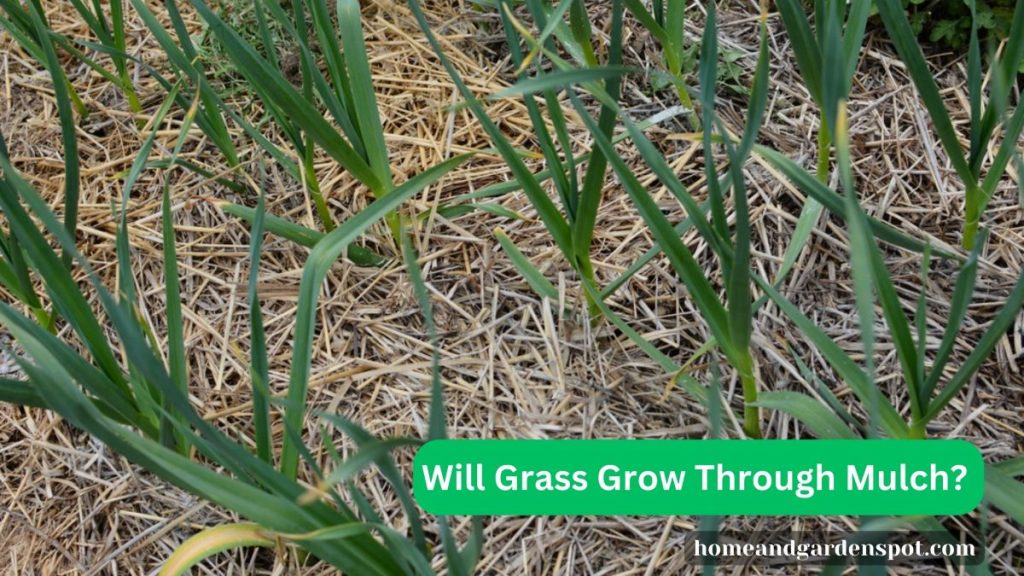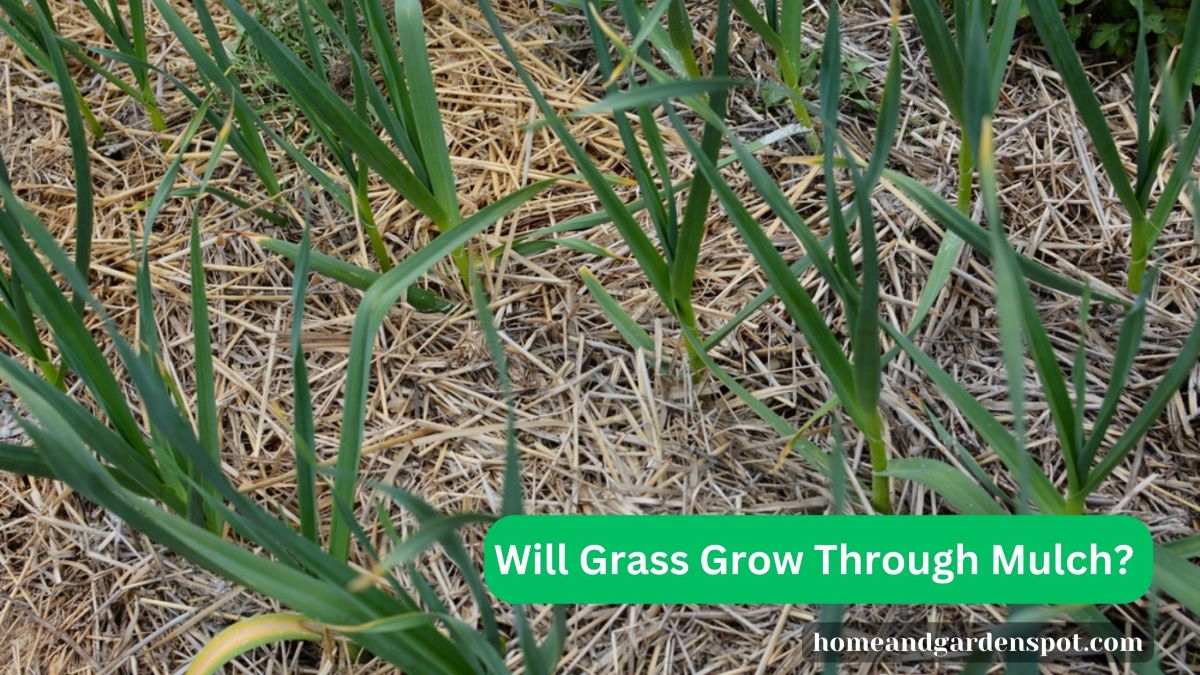Mulch: Is it a friend or foe to your precious lawn?
Every gardener’s dilemma, right?
We all love the benefits of a good mulch layer – moisture retention, weed suppression, and that picture-perfect garden look.
But what about that stubborn grass peeking through, threatening your mulch masterpiece?
Don’t worry, my fellow green thumb!
This guide will answer the age-old question: Will grass grow through mulch? Spoiler alert: Yes, but it depends!
But don’t worry, we’ll uncover the secrets to maintaining a winning mulch-grass balance.
So grab your gardening gloves, and let’s get mulch-ing!

Will Grass Grow Through Mulch?
From my gardening experience, yes, grass has the potential to grow through mulch under specific circumstances.
The key factors influencing whether grass can penetrate and thrive within a mulched area include the thickness and uniformity of the mulch layer, the quality of soil preparation before mulching, the presence of an appropriate growing environment (including good soil quality, organic matter, proper drainage, and regular watering), and the nutrient availability within the mulch.
If the mulch layer is too thin or unevenly spread, it may allow sufficient air and water penetration for grass to emerge.
Notwithstanding, when mulch is correctly applied to create a barrier to sunshine, air, and water penetration, it can effectively inhibit grass growth and weeds beneath it.
How to Prevent Grass From Growing Through Mulch
Preventing grass from growing through mulch is essential to landscaping and gardening maintenance.
There are several effective methods to achieve this goal, each with its advantages:
1. Lay Landscaping Fabric
Landscaping fabric is one of the most common and effective ways to prevent grass and weeds from growing through mulch.
Various landscaping fabric materials, such as polyester, polypropylene, and linen, are available.

These materials allow water to pass through while creating a barrier preventing anything from growing through.
To implement this method:
- Cut the landscaping fabric to size, make holes for your plants, and lay it under the mulch.
- If grass begins to grow through the fabric, it’s likely due to damage or compromise in the fabric, such as holes, tears, or organic breakdown. In such cases, apply a herbicide to kill the unwanted growth and replace the damaged fabric.
2. Spray with Vinegar or Pre-Emergent Herbicide
Organic options like vinegar mixed with salt and dish soap can be used as a homemade herbicide to kill grass and weeds that try to push through the mulch.
Alternatively, you can opt for pre-emergent herbicides (designed to keep seeds from germinating or sprouting), although these chemical solutions should be used cautiously as they can harm desirable plants.
Careful application is essential to prevent damage to your garden.
3. Edge the Mulch Garden
Edging the areas around your mulched flower beds effectively prevents grass and weeds from encroaching on your mulched areas.
Proper edging techniques create a physical barrier that helps maintain the integrity of the mulched beds and prevents weed seeds from infiltrating.
Depending on your aesthetic preferences and budget, there are various types of edging materials, including stones, plastic, wood, metal, composite, and concrete.
4. Lay a Thick Layer of Mulch
A substantial layer of mulch is a natural deterrent to grass and weed growth.
The layer should be thick and dense to effectively prevent grass from growing through mulch, ideally measuring 2 to 3 inches deep.
This thickness creates a smothering shield that hinders the emergence of grass and weeds.
However, not all mulch types are equally effective at preventing growth, so combining this method with the others mentioned above is advisable for comprehensive weed and grass control.

How to Kill Grass and Weeds Under Mulch
1. Pull and Dig
One of the most straightforward methods is manually pulling out and digging grass and weeds.
Use a garden tool like a hoe or a hand trowel to loosen the soil and carefully remove the unwanted vegetation, including the roots.
Be thorough to prevent regrowth.
This method is best suited for smaller areas or with isolated weeds.
2. Smother with Barrier Material
Using a plastic: Lay a thick, black plastic sheet over the mulched area.
Ensure the plastic is opaque to block sunlight effectively and secure the edges with heavy objects or stakes to prevent them from shifting.
Leave the plastic in place for several weeks to months, depending on the weather and the types of weeds.
Lack of sunlight will eventually kill the grass and weeds by depriving them of the energy they need to grow.
Using a Cardboard or Newspaper: Layer cardboard or newspaper sheets over the grass and weed-infested area.
Wet the cardboard or newspaper to help it conform to the ground and stay in place.
Then, cover the barrier with a thick layer of mulch.
Over time, the cardboard or newspaper will break down, and the lack of sunlight will prevent new growth from emerging.
3. Herbicide Application
When dealing with persistent or extensive weed problems, herbicides can be effective.
There are two main types of herbicides to consider:
- Post-emergent herbicides: These are designed to kill existing weeds and grass. Follow the manufacturer’s instructions for proper application. Be cautious when using these herbicides near desirable plants, as they can also harm them.
- Pre-emergent herbicides: These prevent weed seeds from germinating. Apply them before mulching or in early spring to create a weed barrier. Pre-emergent herbicides are particularly useful for long-term weed control.
FAQs
1. How can I stop weeds growing in my mulch in my front yard?
To stop weeds from growing in your mulch bed, use a thick layer (2-3 inches) to block the sunlight they need to germinate.
Consider adding landscape fabric underneath the mulch for extra weed suppression.
2. What is better to mulch grass, or to pick up and compost when cutting my lawn?
Both mulching and composting grass clippings have benefits:
- Mulching: This is a great option if you want to suppress weeds in your flower beds or around trees. The clippings decompose slowly, retaining moisture and regulating soil temperature.
- Composting: If you have a compost bin, this is a better choice for creating nutrient-rich fertilizer for your garden. Grass clippings break down quickly in a compost pile, adding valuable organic matter to your soil.
3. How to keep grass from growing around trees?
- Mulch ring: Apply mulch around the tree trunk (not touching the trunk) to suppress grass.
- Edging: Create a physical barrier between the mulch bed and your lawn.
4. Should you remove grass before laying mulch?
Ideally, yes, for better weed control. But established grass can tolerate a thin mulch layer (1 inch).
Conclusion
Grass can grow through mulch under certain conditions.
The ability of grass to penetrate and thrive within a mulched area depends on factors such as the type of mulch used, its thickness, the condition of the underlying soil, the type of grass, and proper preparation.
When the mulch layer is thin, the soil is conducive to grass growth, and other favorable conditions exist, grass may push through the mulch.
Finally. it’s important to note that when mulch is correctly applied to create a barrier to sunlight, air, and water penetration, it effectively prevents grass from growing through it.
Now you’ve got the power to transform your garden into a masterpiece – mulch maestro, that is!
By following these tips, you can keep your mulch working hard for a beautiful, weed-free haven.
So grab your gardening gloves and get ready to conquer those pesky sprouts!
But wait, there’s more! What are your mulch must-haves?
Share your favorite tips and tricks in the comments below – let’s create a thriving garden community together!

Leave a Reply